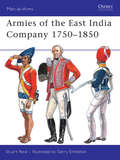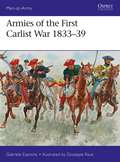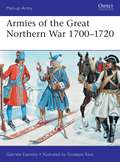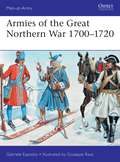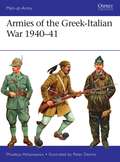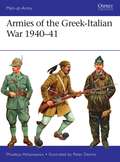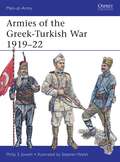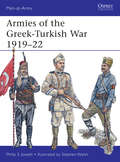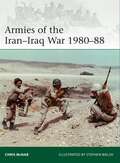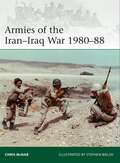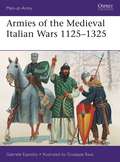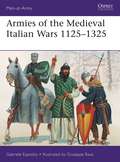- Table View
- List View
The Armies of the Caliphs: Military and Society in the Early Islamic State (Warfare and History)
by Hugh KennedyThe Armies of the Caliphs is the first major study of the relationship between army and society in the early Islamic period, and reveals the pivotal role of the military in politics. Through a thorough examination of recruitment, payment, weaponry and fortifications in the armies, The Armies of the Caliphs offers the most comprehensive view to date of how the early Muslim Empire grew to control so many people. Using Arabic chronicles, surviving documents, and archaeological evidence, this book analyzes the military and the face of battle, and offers a timely reassessment of the early Islamic State.
The Armies of the Caliphs: Military and Society in the Early Islamic State (Warfare and History)
by Hugh KennedyThe Armies of the Caliphs is the first major study of the relationship between army and society in the early Islamic period, and reveals the pivotal role of the military in politics. Through a thorough examination of recruitment, payment, weaponry and fortifications in the armies, The Armies of the Caliphs offers the most comprehensive view to date of how the early Muslim Empire grew to control so many people. Using Arabic chronicles, surviving documents, and archaeological evidence, this book analyzes the military and the face of battle, and offers a timely reassessment of the early Islamic State.
Armies of the East India Company 1750–1850 (Men-at-Arms)
by Gerry Embleton Stuart ReidContrary to popular belief, the capture of India was not accomplished by the British Army, but by the private armies of the East India Company, which grew in size to become larger than that of any European sovereign state. This is the history of its army, examining the many conflicts they fought, their equipment and training, with its regiments of horse, foot and guns, which rivalled those of most European powers. The development of their uniforms, which combined traditional Indian and British dress, is illustrated in detail in this colourful account of the private band of adventurers that successfully captured the jewel of the British Empire.
Armies of the East India Company 1750–1850 (Men-at-Arms #453)
by Gerry Embleton Stuart ReidContrary to popular belief, the capture of India was not accomplished by the British Army, but by the private armies of the East India Company, which grew in size to become larger than that of any European sovereign state. This is the history of its army, examining the many conflicts they fought, their equipment and training, with its regiments of horse, foot and guns, which rivalled those of most European powers. The development of their uniforms, which combined traditional Indian and British dress, is illustrated in detail in this colourful account of the private band of adventurers that successfully captured the jewel of the British Empire.
Armies of the First Carlist War 1833–39 (Men-at-Arms)
by Giuseppe Rava Gabriele EspositoThe First Carlist War broke out after the death of King Ferdinand VII, the king restored at the end of the Peninsular War thanks to Wellington's victory. The crown was claimed by both his daughter Isabella, backed by the Liberal party and his brother Don Carlos, at the head of northern ultra-conservatives centred in the Basque provinces and Navarre. The Liberals or 'Cristinos' were supported by a 10,000-strong British Legion of volunteers led by a former aide to Wellington as well as the British Royal Navy, a Portuguese division, and the French Foreign Legion. With both armies still using Napoleonic weapons and tactics, early victories were won by the Basque general Zumalacarregui. After his death in 1835 a see-saw series of campaigns followed, fought by conventional armies of horse, foot and guns, supported by many irregulars and guerrillas.This little known multi-national campaign provides a fascinating postscript to the Peninsular War of 1808–14, and its uniforms present a colourful and varied spectacle.
Armies of the First Carlist War 1833–39 (Men-at-Arms #515)
by Giuseppe Rava Gabriele EspositoThe First Carlist War broke out after the death of King Ferdinand VII, the king restored at the end of the Peninsular War thanks to Wellington's victory. The crown was claimed by both his daughter Isabella, backed by the Liberal party and his brother Don Carlos, at the head of northern ultra-conservatives centred in the Basque provinces and Navarre. The Liberals or 'Cristinos' were supported by a 10,000-strong British Legion of volunteers led by a former aide to Wellington as well as the British Royal Navy, a Portuguese division, and the French Foreign Legion. With both armies still using Napoleonic weapons and tactics, early victories were won by the Basque general Zumalacarregui. After his death in 1835 a see-saw series of campaigns followed, fought by conventional armies of horse, foot and guns, supported by many irregulars and guerrillas.This little known multi-national campaign provides a fascinating postscript to the Peninsular War of 1808–14, and its uniforms present a colourful and varied spectacle.
Armies of the Great Northern War 1700–1720 (Men-at-Arms)
by Gabriele EspositoThe Great Northern War was a long series of campaigns in which Russia, linked with several other countries in temporary alliances, confronted and eventually replaced Sweden as the predominant power in Northern Europe. While contemporary with the Duke of Marlborough's pivotal campaigns against France, the Great Northern War was in fact more decisive, since it reshaped the Northern European power balance up to the eve of the Napoleonic Wars. It began with a series of astonishing Swedish victories lead by King Charles XII, from Denmark to Poland and deep into Germany. But Peter the Great of Russia showed steadfast determination, and Charles overreached himself when he invaded Russia in 1708; the Russians adopted classic 'scorched earth' tactics until they could destroy the Swedish army at Poltava in 1709, one of the most overwhelming victories in history. Nevertheless, Sweden continued to fight, and frequently win, in Germany, Denmark and Norway, until Charles's death in battle in 1718, though the war itself did not conclude until 1721.This study explores, in detail, the numerous armies and complex alliances engaged in the war for Northern European dominance. Containing accurate full-colour artwork and unrivalled detail, Armies of the Great Northern War offers a vivid insight into the troops which battled for control of the North.
Armies of the Great Northern War 1700–1720 (Men-at-Arms #529)
by Gabriele EspositoThe Great Northern War was a long series of campaigns in which Russia, linked with several other countries in temporary alliances, confronted and eventually replaced Sweden as the predominant power in Northern Europe. While contemporary with the Duke of Marlborough's pivotal campaigns against France, the Great Northern War was in fact more decisive, since it reshaped the Northern European power balance up to the eve of the Napoleonic Wars. It began with a series of astonishing Swedish victories lead by King Charles XII, from Denmark to Poland and deep into Germany. But Peter the Great of Russia showed steadfast determination, and Charles overreached himself when he invaded Russia in 1708; the Russians adopted classic 'scorched earth' tactics until they could destroy the Swedish army at Poltava in 1709, one of the most overwhelming victories in history. Nevertheless, Sweden continued to fight, and frequently win, in Germany, Denmark and Norway, until Charles's death in battle in 1718, though the war itself did not conclude until 1721.This study explores, in detail, the numerous armies and complex alliances engaged in the war for Northern European dominance. Containing accurate full-colour artwork and unrivalled detail, Armies of the Great Northern War offers a vivid insight into the troops which battled for control of the North.
Armies of the Greek-Italian War 1940–41 (Men-at-Arms)
by Peter Dennis Phoebus AthanassiouIn October 1940 an Italian army some 200,000 strong invaded Greece across its largely undefended border with Albania. Although supported by Great Britain, at first by sea and in the air and later by landing British and ANZAC troops from North Africa, Greece bore the main brunt of the six-month war. Outclassed in materiel and outnumbered, LtGen Papagos's Greek army was so successful against the Italians in north-west Greece that, by 22 November 1940, it was advancing into Italian-held Albania. This would eventually force Hitler to send in German reinforcements to support his beleaguered Italian allies, delaying his invasion of the Soviet Union. Complete with contemporary photographs and full-colour uniform plates, this fascinating study explores the history, organization, and appearance of the armies of this oft forgotten conflict.
Armies of the Greek-Italian War 1940–41 (Men-at-Arms)
by Peter Dennis Phoebus AthanassiouIn October 1940 an Italian army some 200,000 strong invaded Greece across its largely undefended border with Albania. Although supported by Great Britain, at first by sea and in the air and later by landing British and ANZAC troops from North Africa, Greece bore the main brunt of the six-month war. Outclassed in materiel and outnumbered, LtGen Papagos's Greek army was so successful against the Italians in north-west Greece that, by 22 November 1940, it was advancing into Italian-held Albania. This would eventually force Hitler to send in German reinforcements to support his beleaguered Italian allies, delaying his invasion of the Soviet Union. Complete with contemporary photographs and full-colour uniform plates, this fascinating study explores the history, organization, and appearance of the armies of this oft forgotten conflict.
Armies of the Greek-Turkish War 1919–22 (Men-at-Arms)
by Stephen Walsh Philip JowettThis is a comprehensive guide to the armies that fought a devastating and decisive conflict in the Eastern Mediterranean between the two World Wars of the 20th century. From the initial Greek invasion, designed to "liberate" the 100,000 ethnic Greeks that lived in Western Turkey and had done for centuries, to Mustafa Kemal Atatürk's incredibly efficient formation of a national government and a regular army, this was a war that shaped the geopolitical landscape of the Mediterranean to this day. It gave birth to the modern Turkish state, displacing millions and creating bitter memories of atrocities committed by both sides. Augmented with very rare photographs and beautiful illustrations, this ground-breaking title explores the history, organization, and appearance of the armies, both guerilla and conventional, that fought in this bloody war.
Armies of the Greek-Turkish War 1919–22 (Men-at-Arms #501)
by Stephen Walsh Philip JowettThis is a comprehensive guide to the armies that fought a devastating and decisive conflict in the Eastern Mediterranean between the two World Wars of the 20th century. From the initial Greek invasion, designed to "liberate" the 100,000 ethnic Greeks that lived in Western Turkey and had done for centuries, to Mustafa Kemal Atatürk's incredibly efficient formation of a national government and a regular army, this was a war that shaped the geopolitical landscape of the Mediterranean to this day. It gave birth to the modern Turkish state, displacing millions and creating bitter memories of atrocities committed by both sides. Augmented with very rare photographs and beautiful illustrations, this ground-breaking title explores the history, organization, and appearance of the armies, both guerilla and conventional, that fought in this bloody war.
Armies of the Iran–Iraq War 1980–88 (Elite)
by Chris McNabDriven by the Iranian Revolution of 1979 and the insecurities it provoked in Saddam Hussein's Iraqi dictatorship, the Iran–Iraq War would become the largest conventional conflict of the period. Curiously little-known considering its scale and longevity, the struggle between Iran and Iraq was primarily fought along the 1,458km border in a series of battles which, despite both sides being armed with modern small arms, armour and aircraft, often degenerated into attritional struggles reminiscent of World War I. Such a comparison was underlined by frequent periods of deadlock, the extensive use of trenches by both sides, and the deployment of chemical weapons by Iraq. Fully illustrated with specially commissioned artwork, this study investigates the organization, appearance and equipment of the ground forces of both sides in the Iran–Iraq War, including Iraq's Republican Guards and Iran's Pasdaran or Islamic Revolutionary Guard Corps. The war resulted in stalemate with some half a million dead and at least as many wounded. The financial costs incurred in waging such a long and debilitating war were one of the spurs that led Saddam Hussein to invade Kuwait barely two years later, setting in motion one of the defining currents of recent Middle-Eastern history.
Armies of the Iran–Iraq War 1980–88 (Elite #239)
by Chris McNabDriven by the Iranian Revolution of 1979 and the insecurities it provoked in Saddam Hussein's Iraqi dictatorship, the Iran–Iraq War would become the largest conventional conflict of the period. Curiously little-known considering its scale and longevity, the struggle between Iran and Iraq was primarily fought along the 1,458km border in a series of battles which, despite both sides being armed with modern small arms, armour and aircraft, often degenerated into attritional struggles reminiscent of World War I. Such a comparison was underlined by frequent periods of deadlock, the extensive use of trenches by both sides, and the deployment of chemical weapons by Iraq. Fully illustrated with specially commissioned artwork, this study investigates the organization, appearance and equipment of the ground forces of both sides in the Iran–Iraq War, including Iraq's Republican Guards and Iran's Pasdaran or Islamic Revolutionary Guard Corps. The war resulted in stalemate with some half a million dead and at least as many wounded. The financial costs incurred in waging such a long and debilitating war were one of the spurs that led Saddam Hussein to invade Kuwait barely two years later, setting in motion one of the defining currents of recent Middle-Eastern history.
Armies of the Irish Rebellion 1798 (Men-at-Arms)
by Gerry Embleton Stuart Reid Sam EmbletonIn 1798, the Irish rose up against the corrupt English government run out of Dublin. Joined by both Protestants and Catholics, the rebellion quickly spread across the country. Although the Irish peasantry were armed mostly with pikes, they were able to overwhelm a number of small, isolated British outposts. However, even with the half-hearted assistance of the French, the Irish could not compete with the organized ranks of the British Army when under competent leadership. In a brutal turning of the tide, the Redcoats plowed through the rebels. In just three months, between 15,000 and 30,000 people died, most of them Irish. This book tells the story of this harsh, but fascinating, period of Irish history and covers the organization and uniforms of the forces involved.
Armies of the Irish Rebellion 1798 (Men-at-Arms #472)
by Stuart ReidIn 1798, the Irish rose up against the corrupt English government run out of Dublin. Joined by both Protestants and Catholics, the rebellion quickly spread across the country. Although the Irish peasantry were armed mostly with pikes, they were able to overwhelm a number of small, isolated British outposts. However, even with the half-hearted assistance of the French, the Irish could not compete with the organized ranks of the British Army when under competent leadership. In a brutal turning of the tide, the Redcoats plowed through the rebels. In just three months, between 15,000 and 30,000 people died, most of them Irish. This book tells the story of this harsh, but fascinating, period of Irish history and covers the organization and uniforms of the forces involved.
Armies of the Italian-Turkish War: Conquest of Libya, 1911–1912 (Men-at-Arms)
by Gabriele EspositoIn the early 1900s, the decaying Ottoman Turkish Empire had lost some of its Balkan territories, but still nominally ruled all of North Africa between British Egypt in the east and French Algeria in the west. Libya had fertile coastal territory, and was the last North African (almost, the last African) region not yet conquered by a European colonialist power. Italy was a young country, ambitious for colonies, but had been defeated in Ethiopia in the 1890s. The Italian government of Giovanni Giolitti was keen to overwrite the memory of that failure, and to gain a strategic grip over the central Mediterranean by seizing Libya, just across the narrows from Sicily. The Italian expeditionary force that landed in October 1911 easily defeated the Ottoman division based in the coastal cities, incurring few losses. However, the Libyan inland tribes reacted furiously to the Italian conquest, and their insurgency cost the Italians thousands of casualties, locking them into the coastal enclaves during a winter stalemate which diminished Italian public enthusiasm for the war. To retrieve Italian prestige the government launched a naval campaign in the Dardanelles and the Dodecanese – the last Turkish held archipelago in the Aegean – in April–May 1912, and landed troops to capture Rhodes. The army finally pushed inland in Libya in July– October (using systematic air reconnaissance, for the first time), and after brutal fighting the war ended in a treaty that brought Italy all it wanted, although though the Libyan tribes would not finally be quelled until after World War I. Containing accurate full-colour artwork and unrivalled detail, Armies of the Italian-Turkish War offers a vivid insight into the troops involved in this pivotal campaign, including the tribal insurgents and the navies of both sides.
Armies of the Italian-Turkish War: Conquest of Libya, 1911–1912 (Men-at-Arms #534)
by Gabriele EspositoIn the early 1900s, the decaying Ottoman Turkish Empire had lost some of its Balkan territories, but still nominally ruled all of North Africa between British Egypt in the east and French Algeria in the west. Libya had fertile coastal territory, and was the last North African (almost, the last African) region not yet conquered by a European colonialist power. Italy was a young country, ambitious for colonies, but had been defeated in Ethiopia in the 1890s. The Italian government of Giovanni Giolitti was keen to overwrite the memory of that failure, and to gain a strategic grip over the central Mediterranean by seizing Libya, just across the narrows from Sicily. The Italian expeditionary force that landed in October 1911 easily defeated the Ottoman division based in the coastal cities, incurring few losses. However, the Libyan inland tribes reacted furiously to the Italian conquest, and their insurgency cost the Italians thousands of casualties, locking them into the coastal enclaves during a winter stalemate which diminished Italian public enthusiasm for the war. To retrieve Italian prestige the government launched a naval campaign in the Dardanelles and the Dodecanese – the last Turkish held archipelago in the Aegean – in April–May 1912, and landed troops to capture Rhodes. The army finally pushed inland in Libya in July– October (using systematic air reconnaissance, for the first time), and after brutal fighting the war ended in a treaty that brought Italy all it wanted, although though the Libyan tribes would not finally be quelled until after World War I. Containing accurate full-colour artwork and unrivalled detail, Armies of the Italian-Turkish War offers a vivid insight into the troops involved in this pivotal campaign, including the tribal insurgents and the navies of both sides.
Armies of the Italian Wars of Unification 1848–70: Piedmont and the Two Sicilies (Men-at-Arms)
by Giuseppe Rava Gabriele EspositoIn the 1840s, post-Napoleonic Italy was 'a geographical expression' – not a country, but a patchwork of states, divided between the Austrian-occupied north, and a Spanish-descended Bourbon monarchy, who ruled the south from Naples. Two decades later, it was a nation united under a single king and government, thanks largely to the efforts of the Kings of Sardinia and Piedmont, and the revolutionary Giuseppe Garibaldi. This book, the first of a two-part series on the armies that fought in the Italian Wars of Unification, examines the Piedmontese and Neapolitan armies that fought in the north and south of the peninsula. Illustrated with prints, early photos and detailed commissioned artwork, this book explores the history, organization, and appearance of the armies that fought to unite the Italian peninsula under one flag.
Armies of the Italian Wars of Unification 1848–70: Papal States, Minor States & Volunteers (Men-at-Arms)
by Giuseppe Rava Gabriele EspositoIn the 1840s, Italy was a patchwork of states. The North was ruled by the Austrian Empire, the South by the Spanish-descended monarchy of the Two Sicilies. Over the next two decades, after wars led by Savoy/Piedmont and volunteers such as Garibaldi, an independent Kingdom of Italy emerged. These conflicts saw foreign interventions and shifting alliances among minor states, and attracted a variety of local and foreign volunteers. This second volume in a two part series covers the armies of the Papal States; the duchies of Tuscany, Parma, and Modena; the republics of Rome and San Marco (Venice) and the transitional Kingdom of Sicily; and the various volunteer movements. These varied armies and militias wore a wide variety of highly colourful uniforms which are brought to life in stunning, specially commissioned, full colour artwork from Giuseppe Rava.
Armies of the Italian Wars of Unification 1848–70: Papal States, Minor States & Volunteers (Men-at-Arms)
by Giuseppe Rava Gabriele EspositoIn the 1840s, Italy was a patchwork of states. The North was ruled by the Austrian Empire, the South by the Spanish-descended monarchy of the Two Sicilies. Over the next two decades, after wars led by Savoy/Piedmont and volunteers such as Garibaldi, an independent Kingdom of Italy emerged. These conflicts saw foreign interventions and shifting alliances among minor states, and attracted a variety of local and foreign volunteers. This second volume in a two part series covers the armies of the Papal States; the duchies of Tuscany, Parma, and Modena; the republics of Rome and San Marco (Venice) and the transitional Kingdom of Sicily; and the various volunteer movements. These varied armies and militias wore a wide variety of highly colourful uniforms which are brought to life in stunning, specially commissioned, full colour artwork from Giuseppe Rava.
Armies of the Italian Wars of Unification 1848–70: Piedmont and the Two Sicilies (Men-at-Arms #512)
by Giuseppe Rava Gabriele EspositoIn the 1840s, post-Napoleonic Italy was 'a geographical expression' – not a country, but a patchwork of states, divided between the Austrian-occupied north, and a Spanish-descended Bourbon monarchy, who ruled the south from Naples. Two decades later, it was a nation united under a single king and government, thanks largely to the efforts of the Kings of Sardinia and Piedmont, and the revolutionary Giuseppe Garibaldi. This book, the first of a two-part series on the armies that fought in the Italian Wars of Unification, examines the Piedmontese and Neapolitan armies that fought in the north and south of the peninsula. Illustrated with prints, early photos and detailed commissioned artwork, this book explores the history, organization, and appearance of the armies that fought to unite the Italian peninsula under one flag.
Armies of the Medieval Italian Wars 1125–1325 (Men-at-Arms #523)
by Giuseppe Rava Gabriele EspositoThe great powers of medieval Europe fought continuously in the Italian peninsula between the 12th and 14th centuries as they sought to expand their territory. Invading armies from Germany – the Holy Roman Empire – saw the creation of the defensive Lombard League of northern Italian city-states. These struggles resulted in conflicts between rival confederacies, which in turn proved to be the catalysts for developments in organisation and tactics. Italian urban militias became better organised and equipped, the Imperial armies went from being mostly German to multi-national forces, and both sides became reliant on mercenary forces to prosecute their wars. After the 1260s, France, relying mainly on armoured cavalry, and Spain, with their innovative light infantry, vied for control of southern Italy. On the seas, the great naval powers of Genoa, Pisa and Venice became fierce rivals, as they created great trading empires, bringing the treasures of the east into feudal Europe. Using detailed colour plates, this beautifully illustrated book describes the myriad of armies and navies that fought for control of Italy in the Middle Ages.
Armies of the Medieval Italian Wars 1125–1325 (Men-at-Arms #523)
by Giuseppe Rava Gabriele EspositoThe great powers of medieval Europe fought continuously in the Italian peninsula between the 12th and 14th centuries as they sought to expand their territory. Invading armies from Germany – the Holy Roman Empire – saw the creation of the defensive Lombard League of northern Italian city-states. These struggles resulted in conflicts between rival confederacies, which in turn proved to be the catalysts for developments in organisation and tactics. Italian urban militias became better organised and equipped, the Imperial armies went from being mostly German to multi-national forces, and both sides became reliant on mercenary forces to prosecute their wars. After the 1260s, France, relying mainly on armoured cavalry, and Spain, with their innovative light infantry, vied for control of southern Italy. On the seas, the great naval powers of Genoa, Pisa and Venice became fierce rivals, as they created great trading empires, bringing the treasures of the east into feudal Europe. Using detailed colour plates, this beautifully illustrated book describes the myriad of armies and navies that fought for control of Italy in the Middle Ages.
Armies of the Muslim Conquest (Men-at-Arms #255)
by Dr David NicolleThe dramatic eruption of the Arab peoples from Arabia after their adoption of the Muslim faith in the 7th century remains one of the most extraordinary events in world history. By the end of that century they ruled a state that stretched from the Atlantic to India, from southern Arabia to Central Asia, covering an area far greater than that of the Roman Empire. Therefore warfare, at least among the nomadic bedouin, was a normal aspect of life. Complemented by numerous illustrations, including eight full page colour plates by Angus McBride, this detailed text by David Nicolle tells the real story of the armies of the Muslim conquest.



